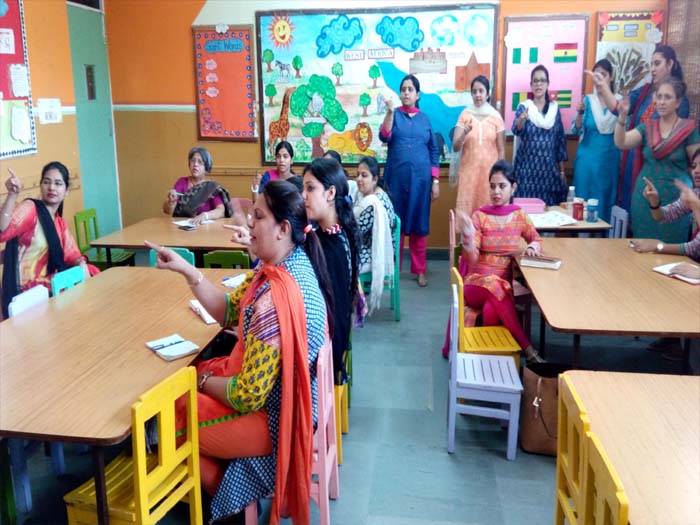Introducing Letters to pre-school and pre-primary students- a teacher workshop.
A workshop on Introducing Letters to pre-school and pre-primary students was attended by teachers on Saturday 6th April 2016 in the Multimedia Room. It was conducted by Ms. Peggy Sood, formerly head of the American Embassy School.
Ms. Sood animated the classroom with interesting activities that engaged every teacher present. She demonstrated stance, language, teacher student interaction and learning objectives a teacher needs to keep focussed about. The workshop was interactive, hands-on, providing moments for reflection and the need to transform the teaching learning process into a thinking classroom, with the teacher not being the sage on stage but just a guide on the side.
[gallery link="file"]
The following suggestions were made to introduce the alphabet at this early level:
Divide the students into groups of 4-5. The groups should undergo a change weekly. This encourages sharing and cooperation.
Different tasks should be given to the different groups relating to their respective alphabet(s). The teacher should be prepared with the same ensuring no student remains idle.
One group may use plasticine to trace a letter, another may trace the letter on a tray with paint in it, while yet another group may paste pictures (from magazines/newspapers/books) which start with the alphabet on a large chart which already has a mix of pictures.
The introduction of the alphabet should be with a story, song, rhyme or phrases that will encourage imprinting the letter in the childs mind.
Many scholastic books can be referred to, in order to strengthen learning. Reading-aloud by the teacher and discussion is recommended to reinforce.
The teacher can then ask the students to share what the tasks they did. Acknowledging and sharing each childs work with the entire class is important to instill confidence and pride in what the children have achieved. Above all, it leads to learning by the other children in the room, simultaneously, as they gain experience through their friends' sharing of the activity.
Besides, introduction to the alphabet, the following were also learnt:
Using phrases like b-bye; baby with action and excitement for the letter b, to introduce or reinforce the sound and the letter is another way to make the children retain.
The teachers need to let go of their inhibitions of looking funny and make it entertaining for the children.
Introducing the lower case before the upper case helps children to relate to the text more easily.
Engaging the students at all times is important for learning to take place. Therefore the teachers should be equipped with various materials such as clay, story books, drawing sheets, memory games, paints, chalk and slates to engage the students at all times.
Introducing vowel sounds by placing them between two consonants is a technique which may help the students as they attempt reading. It would also help to distinguish long and short vowel sounds.
Students should be given books for home to develop an affinity for reading.
Assessments can be administered with the learning process, for the teacher to identify students who have grasped the concept so that she can work with the few who need more practice. The assessment should be easy and quick with a one-to-one interaction between the teacher and each student.
Adequate planning and regular checking of resources and materials was recommended.
Several activities, games and worksheets to engage students were suggested.
Files with a structured plan to teach each alphabet with the relevant resources were provided for future reference.
The workshop concluded by answering queries by teachers and motivating them to implement the strategies suggested for a more effective teaching-learning process.
Ms. Bavleen Kaur













